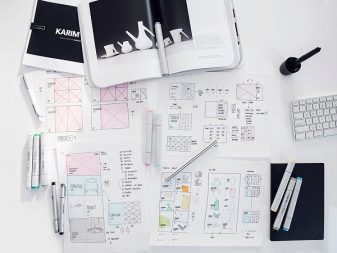UX / UI designers: description and training

There is a huge demand for UX design today, and yet not even all representatives of this field of activity (or related areas) can say with precision what it is. The forefathers of this trend are industrial design specialists, as well as masters of user orientation design and human-machine interaction. At first glance, everything is not entirely clear, and whoever decided to come into this area may get confused in terms. This area is very interesting, promising and, what is especially important, in demand.

Who are they?
UX (User Experience Designer) is a specialist who deals with both design and engineering. This work is connected even more with the second point. The task of this specialist is to ensure that the product on which he is working is as user-friendly as possible. We are talking about both sites and applications. In the functions of a UX designer (or a UI designer, as they also say) - the creation of an attractive product that the user wants to either download, or buy, or place an order on the website.
It can be said that this profession is new, but with a slight clarification. As long as there is a trade and a market, there are also people who are responsible for giving the product an attractive look. Only UX designers use computer tools. If a person wants to master this profession, he will have to analyze whether he has those skills and the background that will become the basis for changing activities. Indeed, beginners rarely come into this area. Graphic designers, marketers with a desire to master a new specialty, become good UX designers.
Sometimes a UX designer also performs the functions of a UI designer (User Interface).Therefore, both names are actively used on the market today, substituting for each other. But to be precise, UX is the structure of the product, the comfort of its use, and UI is the appearance, successful color combinations.
Although, of course, both can be performed by one person, and not very large companies are often looking for a part-time job.

Pros and cons of the profession
The main plus is the demand in the labor market. And the demand for such craftsmen is only growing.
Undeniable advantages of the profession:
- high level of remuneration;
- professional growth (there is little stagnation in this area of activity, you need to improve all the time, adjust to changing standards);
- the ability to work remotely (the main advantage for those who would like to spend the winter in warm countries);
- the possibility of retraining in related fields ("horizontal" career growth);
- high probability of development of supra-professional skills.
But it does not do without minuses, as, indeed, in any other profession. What some job seekers fear:
- high competition;
- the employer can ask the applicant for a detailed portfolio;
- you need to constantly conduct research among users;
- a high level of responsibility for the final result.
Although all the disadvantages can be called conditional, especially for a person who is confident in his abilities.
But a really significant disadvantage of the profession can be considered the need for a long stay at the monitor. But physical inactivity can also be combated by compensating for it with physical activity outside of work.

What do they do?
And now to the specifics - the field of activity of a UX designer is large, and every company that invites this specialist to it should clearly outline it. The contract usually prescribes job responsibilities, which must be carefully read before signing the document.
What these responsibilities usually include:
- analysis of user scenarios;
- development of a clickable product prototype;
- formation of a portrait of the target audience (target audience);
- work on the logic of using the product;
- prototype testing, correction based on testing results;
- repeating development-testing cycles until the end result is achieved - the optimal user interaction with the product.
Research is a significant part of this specialist's job. And every person who decides to embark on this professional path, both morally and intellectually, must be ready for this. Of course, you need to have your own ideas about the prototype and the final product, but even developed intuition without real research does not matter.
In part, a UX designer is both a marketer and a business analyst, but at the same time, it is impossible to take place in the profession without a direct designer's "eye". As well as without developed skills, practical experience.

Requirements
To say that skills are everything, and personal qualities simply help to achieve success faster, of course, is possible. But that would be an exaggeration. To achieve goals, a balance of both is very necessary. No matter how smart and talented a person is, if he simply cannot organize his working regime, working remotely, he will fail.
Personal qualities
Strong analysts remain in this profession. This can be developed, but the natural tendency towards qualitative analysis is difficult to overcome. There are people who are able to think in such a way that not a single nuance will slip out of their control. They make great analysts, tactics, and practitioners. For those who find full project analysis boring and routine, it will be difficult to become a good UX designer. What other personal qualities are useful in the profession?
- Clear self-organization... Time management is the power of the profession. If you correctly allocate time resources, understand your strengths and, for example, know when to analyze and when to structure, everything will work out.A person with such skills does not have procrastination (which every second office worker complains about today), there are no “burning” projects and failed deadlines.
- Scrupulousness... Sometimes you have to tinker with the little things all day. The professional should not be tempted to do "as is" and move on to the next step.
- The need for self-development... The market is growing and developing, technologies are improving, the requirements of the employer are also changing. And these are realities that a UX designer cannot turn a blind eye to.
- Self confidence... At first glance, this is not the most important personal quality for a specialist who often works “remotely”. But smart and talented designers are often left behind in the profession, because they could not cope with self-presentation, showed themselves unsuccessfully in an interview, and were afraid to take on a complex project.
- Psychological flexibility... And emotional too. If a person gets depressed over one unsuccessful project, is faced with despair over a trifling comment from one disgruntled user, he will not survive the professional race. You need to stay cool, be able to predict and learn from your mistakes.
- Initiative... It is, of course, possible to be "quiet" in this profession. But, as you know, the globe is turned by optimists and activists. Even if the TOR of the head is clear and strict, and it is not desirable to deviate from it, and the UX designer sees a different solution, he should not be afraid to voice it. Striving to do better rather than “do it that way” is a key quality of a successful UX designer.
The list can be continued, the main thing is, even before starting in the profession, to understand that even a red diploma and high intelligence do not guarantee a dizzying career. While the clever girls are resting on their laurels, the diligent and hardworking overtake them in their careers.

Skills
Technical aspects, oddly enough, are the simplest in the profession. It is not so difficult to learn and master them. But successfully apply, promote, convince, guess - this is something without which techniques remain ineffective. Let's list the basic professional skills of a UX designer.
- Professional communication... "You can be withdrawn and self-sufficient in life, but at work, be prepared for productive negotiations." The leader can start a conversation with such a phrase. A UX designer has to interact with a large number of people, from other designers to users, product managers and executives. Negotiating, co-organizing - all this you need to be able to in order for the end result to be successful and profitable. To be able to listen, to be able to speak is really hyperimportant for this specialist.
- Research experience... If you do not know the users, it is simply impossible to create a product for them. Communication with them is the most powerful lever in the hands of a UX designer. He must receive an assessment of the product, idea, function and then use the information received correctly.
- Information architecture... This is the main set of specialist tools that will allow him to turn any chaos into an orderly system. This is the hierarchy of the menu, and the priority of items, and the choice of clickable words.
- Teamwork... The more necessary specialists the designer includes in the design process, the more thoughtful and optimized it will turn out. There is no need to be afraid of collaborations and there is no need to always “pull the blanket over yourself”.
- Assembling interaction scenarios and layouts... A layout is the skeleton of an interface, and an interaction scenario is a sequence of layouts. To work out the layouts, you do not need to sit down at the computer, they are best worked out on paper (although this is not easy, and also labor-intensive).
- Copywriting... Being able to write capacious texts for the interface is a great advantage for a UX designer. If you have philological inclinations, you can train this skill.
Much more comes with experience, but with basic skills you need to be at the start of your professional path.


Education
There is no such specialty in Russian universities yet. But the requirements of companies often differ, and a strict list of job responsibilities is also impossible to find. Because of this, UX designers are usually graphic or industrial designers. And these specialties can be studied in a large number of higher educational institutions.
In addition, many private IT schools offer training courses in this specialty, and on the basis of an already having higher education (possibly in a related specialization), you can get excellent training.









